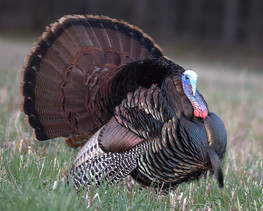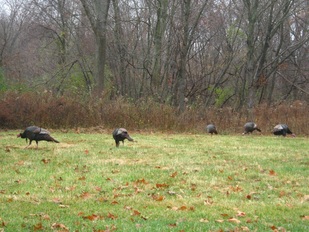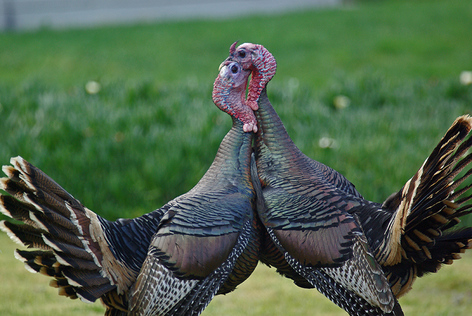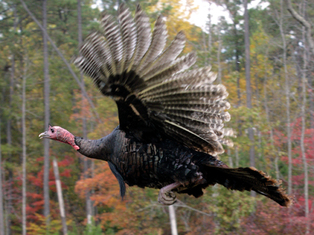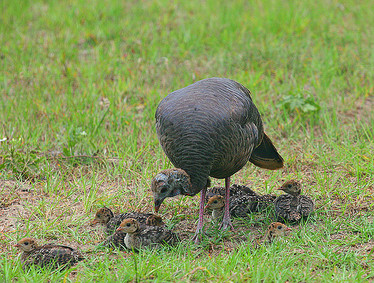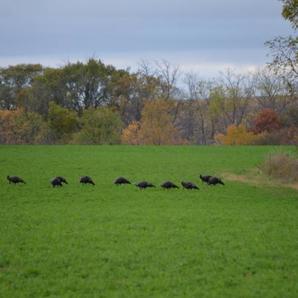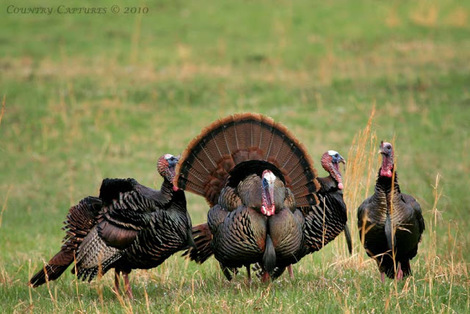Turkey Hunting
Spring is just around the corner. With it brings a renewed beginning and
celebration of nature. The cold weather
gives way to friendlier temperatures.
The water’s thaw and fish are hungry.
The plant life returns with a grand flora. Along with all this comes a special and
treasured time for the hunter and huntress who seek out the adventure of
pursing the Wild Turkey. Unlike the
domestic turkeys that are consumed during the fall and winter, the wild turkey
is a very cautious and adapt animal.
To zoologists the wild turkey is referred to as Meleagris Gallopavo. This species of animal has six sub-species. Of the six (Eastern, Osceola, Rio Grande, Merriam, Gould and Ocellated) the Eastern is the only turkey native to Illinois. Though native to North America, the animal got it’s name from British, who imported domestic animal’s from Spain and was associated with Turkey, thus the name stuck once they seen the wild variety. The wild turkey is a true success story of conservation in the United States. At the early part of the 20th century it was estimated that fewer than 30,000 birds existed in the United States. Through the efforts of organized groups and hunters, the animals have come back from near extinction. One hunter’s invention and improvement of the Net Gun facilitated relocation. The group efforts of outdoorsmen and women, along with the close work of conservation by states and concerned people, the wild turkey is flourishing once again.
The bird is quite allusive. Then again you would be too if everything in your world was trying to eat you even before you were born. Statistically, the odd’s of a wild turkey living past the age of 2 years in the wild is very small. First, there are plenty of “critters” that are seeking out the eggs, opossum, raccoon and snakes are just a few. Then once hatched, the “Poults” (a new born turkey) have to fight from the beginning for survival as they are very vulnerable to the weather. Turkeys are “precocial”, meaning they are born with their feathers on. They will follow there mother (called a Jenny) and learn how to seek grubs and insects. They will become vocal at and early age and learn the language. When she gives a “putt” they freeze in place, until she gives them the all clear signal. About 8-10 days they will be strong enough to fly. Then they will begin to roost in tree’s gaining safety from the ground, though some species of birds will still prey upon them.
To zoologists the wild turkey is referred to as Meleagris Gallopavo. This species of animal has six sub-species. Of the six (Eastern, Osceola, Rio Grande, Merriam, Gould and Ocellated) the Eastern is the only turkey native to Illinois. Though native to North America, the animal got it’s name from British, who imported domestic animal’s from Spain and was associated with Turkey, thus the name stuck once they seen the wild variety. The wild turkey is a true success story of conservation in the United States. At the early part of the 20th century it was estimated that fewer than 30,000 birds existed in the United States. Through the efforts of organized groups and hunters, the animals have come back from near extinction. One hunter’s invention and improvement of the Net Gun facilitated relocation. The group efforts of outdoorsmen and women, along with the close work of conservation by states and concerned people, the wild turkey is flourishing once again.
The bird is quite allusive. Then again you would be too if everything in your world was trying to eat you even before you were born. Statistically, the odd’s of a wild turkey living past the age of 2 years in the wild is very small. First, there are plenty of “critters” that are seeking out the eggs, opossum, raccoon and snakes are just a few. Then once hatched, the “Poults” (a new born turkey) have to fight from the beginning for survival as they are very vulnerable to the weather. Turkeys are “precocial”, meaning they are born with their feathers on. They will follow there mother (called a Jenny) and learn how to seek grubs and insects. They will become vocal at and early age and learn the language. When she gives a “putt” they freeze in place, until she gives them the all clear signal. About 8-10 days they will be strong enough to fly. Then they will begin to roost in tree’s gaining safety from the ground, though some species of birds will still prey upon them.
As the summer progress’s; so will the turkey. They will seek out grubs and insects for
protein and also eat corn and other plant life.
They will be extremely vigilant as coyote’s will constantly be trying to
feed upon them. As the aggressive
insects (mosquitos and ticks) become more prevalent, the turkey will seek out
“dusting spots”. They will find a place
with dry dirt and literal dust themselves which will keep the majority of
insects off of there roughly 5,500 feathers on an adult wild turkey. The turkey’s live within a “flock”. This way they can protect themselves. If you watch a flock feed, there will always
be at least one looking around for prey.
They constantly communicate, having over 32 words in there language, the
“cluck” being the most used. Through out
there first year they will evolve and learn to survive, also they will
establish a “pecking order”. Through
various nips and spur fights they will decide where they are at, both males and
females do this.
After the first year, the animals are ready to breed. The males (young one called Jake, older call a Tom) will venture away from the flock as spring breaks. Note: tom’s over 4 years have been known to stay together in there own flock through out the year. With spring in the air, the Tom will start to seek out a few mates to breed. In the morning, the Jenny’s (who is ready to breed as well), will give a “tree yelp”, like a soft wake up call to all on the roost, letting them know I am getting down. The Tom will hear this and once he is on the ground will “gobble”, to let the Jenny’s know where he is. The Jenny’s will call back to him and they will communicate till they meet up. Typically, the Tom will go so far and wait for the Jenny to come to him. Once they are together, they will find a secluded spot. Once done, he will go seek out another; she will go and find a suitable place for a nest. The Tom will “dance” for the lady called strutting. His snood, piece of skin on his head will become elongated and his head will actually turn colors from white, to blue to red. Though the turkey’s hearing is not very good, they hear high pitches better than any other sound. The turkey’s sense of smell has been estimated to be on par with ours or a little worse. However, there vision is extremely good, they also see color as good if not better than we do. Coupling their vision with their sense of awareness makes the wild turkey one of the hardest animals to hunt.
Wild Turkey hunting is enjoyable and an adventure. In Illinois, we have two seasons, a spring and a fall. In the spring, you get a tag through a drawing. Once you have it, you want to get out there during your “season” (a week long) well before sunrise. You can give an owl hoot, and the Tom will “shock gobble” giving away his location. They do this due to a natural dislike of each species. Once the Tom does this, you can get within a hundred yards of him and set up. If at all possible, you want to set up against a tree that is as wide as you for two reasons. One, it helps to keep your silhouette hidden, and two, it protects you from another hunter whom might be “hunting” the same bird (we will discuss safety in a short while). Once, the Tom is on the ground, you will call softly to him trying to “lure” him into you. Though we are going against nature, getting close will keep him from loosing interest or getting henned up (meeting a Jenny). But getting closer to 100 yards of those eyes is tough, and typically you will bump him away.
The Tom does not come in the same way all the time. I have had them gobble all the way in to
literally 5’ (five feet), and had them shut up and sneak in. Of all the things in your “toolbox” for
hunting them, patience and woodsmanship is the most important. Once, you hear the Tom coming in and/or see
him, get ready. You want to shoot the
turkey in the head/neck area. Those
5,500 feathers are like armor and will stop shot.
If the turkey comes in and “spooks” or goes another direction, do not give up, wait a little while. Then just use your woodsmanship skills and work ahead of him and try again. However, from my experience, if you bump into him again or he moves off, it is better to back out and come back another day. Other wise you will scare him out of the area, why do that if you have an idea where he is now?
Fall hunting tags with a bow are available over the counter, shotgun, again, is by drawing. There are two camps of thought for the fall. One is the old way of finding a flock, then running into it and “busting” up the flock, then setting up between the lead bird and the others, as she calls them back together she calls the birds to you also. The other camp look’s at hunting the flock, instead of “busting” it up. Call to the birds, using fall calling techniques, which makes it even more challenging because there are more eyes.
If the turkey comes in and “spooks” or goes another direction, do not give up, wait a little while. Then just use your woodsmanship skills and work ahead of him and try again. However, from my experience, if you bump into him again or he moves off, it is better to back out and come back another day. Other wise you will scare him out of the area, why do that if you have an idea where he is now?
Fall hunting tags with a bow are available over the counter, shotgun, again, is by drawing. There are two camps of thought for the fall. One is the old way of finding a flock, then running into it and “busting” up the flock, then setting up between the lead bird and the others, as she calls them back together she calls the birds to you also. The other camp look’s at hunting the flock, instead of “busting” it up. Call to the birds, using fall calling techniques, which makes it even more challenging because there are more eyes.
Spring hunting has its challenges, one of them is
safety. Think of this we are going after
a bird, though big for and Aves, is dark in a lush, thick foliage of spring. It is making noise which attracted us to
him. We get close and notice some
movement, so we slowly get our shotgun up.
Then we see the white color of a turkey head, though not clearly, you
convince yourself it’s him. You shoot, and
then hear a yell. You just shot another
hunter that was calling to a turkey; the white color is a white handkerchief hanging
out of his back pocket. This is not
fiction, this actually happens!! This
hunter has had a few close calls of his own, but that is for another time. As we discussed, set up with something solid
at your back. Also, apply the NRA
firearm safety rules:
Know and be sure of your target and what is beyond.
Keep your finger off the trigger till you are ready to shoot.
Keep your muzzle pointed in a safe direction.
When ever you hear a turkey, approach it cautiously. You want to keep a sharp eye out for another person hunting it and/or calling to it. Be aware that you will not be alone in the woods. With great spring turkey hunting, also comes great mushroom hunting. Though most of the public areas restrict mushrooms hunters from going into the woods during turkey hunting times (you can only hunt until 13:00), people go in and hunt mushrooms anyway. I have more than a few stories of very close encounters with mushroom hunters, but again for another time.
Know and be sure of your target and what is beyond.
Keep your finger off the trigger till you are ready to shoot.
Keep your muzzle pointed in a safe direction.
When ever you hear a turkey, approach it cautiously. You want to keep a sharp eye out for another person hunting it and/or calling to it. Be aware that you will not be alone in the woods. With great spring turkey hunting, also comes great mushroom hunting. Though most of the public areas restrict mushrooms hunters from going into the woods during turkey hunting times (you can only hunt until 13:00), people go in and hunt mushrooms anyway. I have more than a few stories of very close encounters with mushroom hunters, but again for another time.
I view knowing the pattern of your shotgun as safety as
well. (Also called patterning your shot)
You want to know what your “load” is doing at 20, 30 and 40 yards. There are free targets to print off the
internet or you can get them from the National Wild Turkey Federation
(NWTF). I recommend looking at there
site, they have a lot of great information.
Three other safety concerns should be prevalent to you as well. One, know your area! Many people hunt the fall; the woods look
totally different in the spring, and have encountered more than one person who
got turned around (having a compass and knowing how to use it is nice, I’ll be
glad to show anyone). The second is
hydration. Do not just drink a few cups
of coffee in the morning, have a glass of water also, it will make a huge
difference. I always carry some water
with me. The third is pesky insects, not
only do they bother people, but more and more insects transmit disease. Though malaria was eradicated in the early 20th
century in the United States it is making a comeback, transmitted by mosquitoes. Tick’s are active at this time as well and
carry Lyme disease which takes along time to cure. A good DEET repellant on your clothes works
for both (never apply straight to your skin).
A product that I have used since it first came out is a THERMACELL. This little device will keep mosquitos away
for a long time and you can hunt without the pest.
I have hunted Turkeys for 20 years and have some great
memories of interacting with them and with friends. But, the best memories I have is when I have
taken new hunters out to the turkey woods.
I have taken children and adults out to the field. Sharing the wonders of the wild turkey in the
woods with them is great. They ask
questions and help me become rejuvenated with the magic that nature holds for
us all. Do yourself a favor take a new
person out with you.
I hope you enjoyed this article and if you decide to venture out to the woods, be safe. Don’t just have blinders on; enjoy all that nature has to offer.
Todd R. Mendenhall
I hope you enjoyed this article and if you decide to venture out to the woods, be safe. Don’t just have blinders on; enjoy all that nature has to offer.
Todd R. Mendenhall
